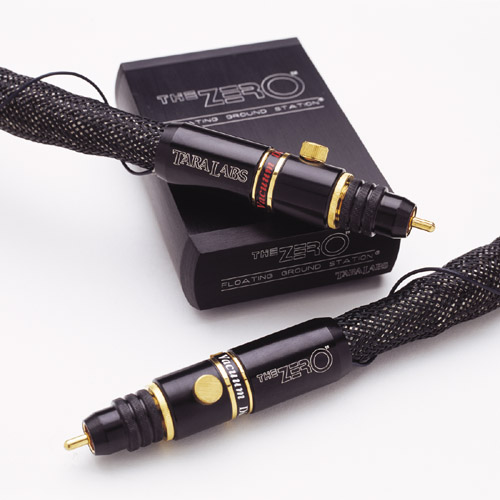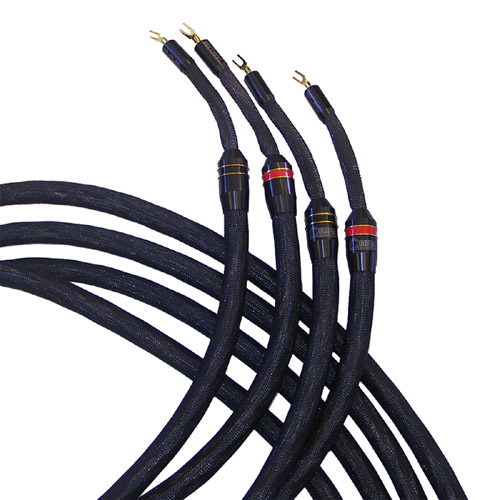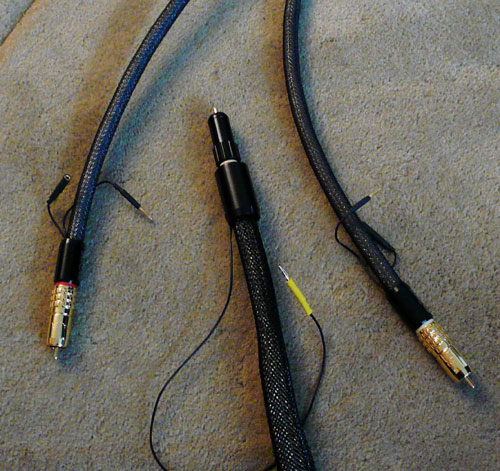
You are reading the older HTML site
Positive Feedback ISSUE
july/august 2008
tara labs
Zero and Omega cables - the Next-Gen est arrivé
as reviewed by Marshall Nack

|
"Friggin' amazing. You can hear it breathing."
"Yeah. The air is pumping through the bellows: Oompf… Whoosh… Oompf… Whoosh."
"It's like a heartbeat."
No, this was not midnight in Dr. Frankenstein's lab, or an evening performance of Young Frankenstein, the Broadway musical. The scene was the third of my living room given over to EL SISTEMA, and we were commenting on the bandoneon from "Minor Waltz," track two of Doubles Jeux (naïve v 5066), a fairly ordinary showpiece for the young violinist Laurent Korcia that just happens to be quite realistically recorded. Earlier, that instrument sounded like a truncated, barking cough, something like: Ehh… Ehh… Ehh. Know what I mean?
Again, on the eponymous track from Sempre libera (DG 00289 474 8812), the tenor shadowing Anna Netrebko began the evening locked in a distant, offstage closet, a ghost-like chiaroscuro of a professional singer. This was through TARA Labs The 0.8 signal wire and The One AC power cords.

We observed him escape from the closet and advance along the left wing of the stage when a length of the new TARA Labs OMEGA Edge speaker wire was swapped in.
Then he seemed to shuffle onto the stage proper, locating himself well behind and to the left of Ms. Netrebko, with the addition of a single length of The One XL Cobalt power cable. From that point, as additional cable was swapped in, he stopped roaming and just grew in bulk and substance, grounded to earth as a person subject to the laws of gravity should be.
In case you haven't heard, Netrebko is the current "It" girl in opera circles. On this disc she sounds fabulous, as does the highly effective Mahler Chamber Orchestra under Claudio Abbado. The voice everyone is raving about is here, in all its splendor, and it presents a treacherous audio obstacle course to navigate.
In a system with dynamic openness, that is, one that responds sensitively to signal changes and has wide enough range to allow crescendos to go wherever they want so that you don't feel any blockage, you will hear high notes that'll make you catch your breath. That Netrebko does so with power and support is what separates her from a competitor like Natalie Dessay, for example.
Ms. Netrebko's wonderful high notes were truthfully revealed for the first time. Her ascent was a smooth and stress-less ride of unvarying quality. Dynamic range was staggering. And she stayed put in a fixed location on the stage—there was no frequency-based shifting of location. Netrebko's superb gift was suddenly more perfect, and more rare. Now I see how truly special she is. And now I see that it's possible for cables to have that quality of dynamic openness, too. The Next-Gen are super-sensitive to signal changes; moreover, they respond linearly, that is, the treble expands in lock step with the mids and bass.
Oy!
It embarrasses me to think back to before the cable swap. I've been using this disc as a demo CD, anxious to show it off to visiting ears. And, to a man, like me, they were likewise impressed. Indeed, I was able to get away with this because I was so thrilled not to hear gross break-up and distortion in her enormous dynamic range. That it was smooth, grainless and extended also helped. But now I understood—what I heard before was false. I saw clearly how uneven and jagged it was. Whenever she hit a high C, there was the same hardening. Then when she reached, say, high F, another type of artifact set in. (N.B. These note values are for illustration purposes.) The changes were consistent and repeatable. I had rationalized her lumpy ride up the scale as "the way she sounds live."
Needless to say, I've never heard her in person.
The Timbral Envelope
On first listen, there is a very good chance you might think these Next-Gen wires overdo the timbral envelope—I did. It certainly seemed so compared to what I was used to hearing. Go ahead, put back your previous cable and listen again. Does it now seem like something's missing, that you are hearing a less realistic portrait?
Timbral portrayal is stunning. Ultimately, I judge timbre by how my gut reacts. If the sound leaves me a little queasy, I know something's amiss. The Next-Gen leaves my digestive tract happy. It is wholesome. Nothing is left out and nothing is exaggerated; timbral treatment is as evenhanded as frequency response is flat.
SoundStage
Very occasionally I come upon a system that gives me a tangible sense of immersion, one where the physical speakers have dissolved as the origin of the sound and the sound stage moves freely in all directions in front of and behind the speaker plane.

Omega Speaker cable
The Next-Gen stage is crowded with information. Don't be surprised if images appear swollen with much more mass and body (especially after the power cord and speaker wire swap), and every image has its own 3-D and plenty of air (especially after the interconnect swap). If you want, you can gaze over at the left front and "chew" on those events. Or check out that little tenor in the far left corner; digest his image for a while. The focus is intense and steady, but without spotlighting or etched borders.
Transient Handling
Different instruments have varying ways of exciting the air around them. Likewise, today's best cable designs are dominated by two kinds of transient treatment. The Next-Gen opts for genteel sophistication. Its leading edge is almost a non-event. It appears unheralded, and to a large degree merges seamlessly into the notes' sustain. Events don't pop out at you; they stay in the plane of the soundstage, where they belong. The alternate approach involves a more exciting onset that is different in character from the sustain—thus it catches your attention. Many cables opt for the later approach, even pushing it to the point of showiness and a distorted leading edge.
The Sustain
The Next-Gen handles the following part, the sustain, by packing it chock full of info. Once again, access to these details is so free and stressless that when I put back even the finest of my cables it sounds like there's a bottleneck hampering resolution, especially in the low frequencies.
Occasionally, as I moved components around, I found such free access to all this detail verging on airy and ethereal. Then I would put in a single length of cable with the other kind of sustain to add mass and earthy characteristics. Invariably, these gains were offset by a falloff in detail and inner complexity.
The Decay
While some decay trails seem to go on forever, others are about what I'm used to hearing. These cables extract every last bit of the diminishing signal and support it all the way until it disappears, as befits the source.
The difficulty in describing these wires is that they're so elusive. I can't decide whether they're warm or cool, dry or liquid, limber or tight, because at times they are all of these. They seem to be warm—they certainly have things I associate with warmth, like liquidity, ease and wholly fleshed out timbre. But on the other hand, they are definitely accurate and revealing. They can seem analytic in the sense that so much is laid out before you. If you have issues anywhere, you're going to know about them. Which means the more Next-Gen you incorporate, the more imperative it becomes to fix the problems.
Usually this much information comes with dry sounding cables, but these are not dry. On the contrary, the Next-Gen give instruments room to breathe. They exercise tight control over the signal yet they excel at connecting the dots that allows music to flow.
Real-world sound comes in a spectrum ranging from downright unpleasant to warm and beautiful. The Next-Gen is voiced towards the pretty side of that spectrum. Compared to other TARA cables, such as The 0.8, the Next-Gen are prettier sounding. The Next-Gen are both beautiful and realistic sounding.
The One XL Cobalt PC
The presentation seems to have gone on a liquid protein diet with The One XL Cobalt PC (MSRP $4800. N.B.: There are now three levels of power cords above The One AC: The One Onyx, The One Gold, and The One XL Cobalt). Put aside concerns about weight and body—the XL Cobalt power cord introduces so much mass and muscle, well beyond the current The One AC power cord, that I had to lighten up by removing a couple of Harmonix RFA-78i room tuning discs. Confoundingly, the XL Cobalt PC also adds control, so it's not only richer and weighty—it has better timing and resolution.
The One AC and XL Cobalt PC
I recall one instance with my old RCA Shaded Dog LP of Tchaikovsky 1812 Overture (LSC 2241). When the XL Cobalt was in the equation it was suddenly apparent that the timpani came in a half beat behind the rest of the orchestra—a surprising slip-up for the legendary ensemble work of the Chicago Symphony Orchestra under Fritz Reiner.
original ZERO
I've been listening to loaned samples of the first generation The ZERO IC and digital cables for a long time. (The original model is now referred to as The ZERO Gold. The ICs have also undergone cloning. There are three levels, all designated The ZERO. In increasing cost, they are: The ZERO Edge, ZERO Onyx, and ZERO Gold.)
Stepping down from the ZERO Gold to the Onyx to the 0.8 was instructive. Increasingly less low-level info is available as the granularity of the sound pixels coarsens—you lose micro information and the frequency extremes become pronounced.

The 0.8 and Onyx IC
I recognize the sound of The 0.8—it's my familiar reference—but I can't believe how coarse, almost brusque, it seems in comparison. And its gotten much darker.
My, what big notes you have!
Moving in the reverse direction up the line through the three levels of OMEGA speaker wire (the ZERO refers to interconnects; the OMEGA is the equivalent in speaker wire, and yes, there are now three of them) took everything I've said above and made it bigger.
I began with the OMEGA Edge (MSRP $12,800) and moved to the OMEGA Onyx (MSRP $15,000). But, what's this? The whole picture got dark, smooth and ripe, the top end lost its sparkle and frequency response was uneven. Double bass notes certainly became round and full but also noticeably plummy.
Something was amiss. I put my thinking cap on. Looking around…
¡Estúpido! My gaze fixed on a pile of 9m OMEGA Onyx ICs I had burning in. There were two of these coiled around in a neat heap in front of my rack. One was connected to the tuner, the other between the amp and preamp.
ZERO Onyx Coil
I remembered that when you coil wires, you create an electro-magnetic field. Well, nine meters is roughly thirty feet: what was I supposed to do—run them around the entire living room? I stopped critical listening 'til they were cooked.
Next Gen Speaker wires
The OMEGA Onyx speaker wire has about the same tonal balance as the Edge, but is smooth, effortless, more detailed, fulsome and dynamic—and more true. It broadens the image of massed strings, such that finally there is the equivalent of a section of first violins—first time I'm hearing that. Out came some more Harmonix RFA-78i's. (I'm finding the need for these third party tweaks is in inverse proportion to the quality of the gear. And as you get better quality, they actually become deleterious.)
Then I swapped in the OMEGA Gold speaker wire (MSRP $22,000). If the difference between the Edge and the Onyx came to about 5%, it is the same again going to the Gold.
There was more of everything good, especially 3-D image depth, slam and dynamic range, along with tons of atmosphere. The adjectives that best sum it up are control and liquidity, another darn contradiction. You heard deeper into the performance and each note proceeded after the previous fully developed note in an unrestrained flow, a quality that's usually the province of fine tube gear. Only now it was emanating from my mbl Noble Line separates. And this timbral beauty was delivered along with newly fearsome dynamics. Dynamic peaks expanded ‘til they had no more space to fill. The room's dimensions became the limitation.
Fit-n-Finish – Interconnects
Cable jewelry design and construction keep advancing. TARA Labs has always been known for premium quality: the Next-Gen clearly nudges a step ahead.
A White Paper on TARA Labs' Website states the mission. "The best interconnect would comprise a pair of signal carrying conductors suspended in air, or more ideally, in a vacuum… (The) air-tube design is unique in that it has internal galleries or arteries that run along the inside walls of the tube. These galleries… hold conductors."
The ZERO interconnects look like robust, bulked-up versions of TARA's other product lines. The construction technique employs a Teflon center tube of much thicker diameter. The ZERO weighs about the same but is less flexible than The 0.8 series.
If you make a sharp bend, the center tube will buckle at that point, but I'm told this does no harm to the conductors inside because they are made from very thin, 22 gauge, super-annealed copper, which is soft and malleable. With that advice in mind, I had no problems routing it wherever I needed it to go.
The three levels of ZERO interconnects come dressed in full black, from tip to toe. The length of conductor looks similar from one to the next in terms of dielectric covering, girth and weight. All say "THE ZERO." Where you can tell one level from the other is the termination. Only the Gold IC has the enlarged barrel with the patented threaded screw on the collar to contain the vacuum. And it has a flexible section of the Teflon center tube just beyond the termination that makes it easier to twist into position.
As the Onyx and Edge IC do not have a vacuum, their XLR barrel is considerably shorter, and they don't have a flexible section.
The new ZERO Gold sounds the same as the first generation Gold, although there are small cosmetic differences. The new Gold has a yellow band dielectric covering the ground wire pigtails. The older ones have a black plastic covering. The new cables say Gold and "SV Technology" (sealed vacuum) on the termination barrels and the ground station that comes with them has been improved—it is now called a High Frequency eXtended Floating Ground Station (HFX FGS for short).
True Floating Ground
Like the less costly TARA The 0.8 series, the ZERO ICs and digital wire have pigtail sproutings on both ends to float the ground. The source has mini-banana pigtails that plug into the outboard HFX FGS. The HFX FGS, in turn, is connected via mini-pins to the ground post on your preamp. On the load side of the ZERO IC mating mini-pins lock together. Thus, the ground wire is lifted on both ends. This comprises a true floating ground.
HFX FGS Ground Station
The Ground Stations employ passive noise reduction technology in the form of a patented compound called Cerelex. Whatever EMI/RFI is riding along the ground wire is dumped into the HFX FGS and absorbed by the Cerelex inside.
Even without the HFX FGS, you will experience less noise. These are among the quietest, full-range cables available. But for the ultimate in noise reduction and smooth response, try one. (The upgraded HFX FGS can be purchased separately: MSRP $1200.)
The Floating Ground Station doesn't change tone or timbre but makes everything clear and sharp: in a word, pristine. Often it may make it seem louder. Sometimes I found it impacted treble response; I guess I had "noise" riding on top, only I thought of it as "air." When it was removed, it seemed less extended. With problematic gear that has audible grain or treble issues, the HFX FGS made a big difference.
Fit-n-Finish - The One XL Cobalt PC
The One XL Cobalt PC (MSRP $4800/2 m) is physically a beefier version of The One AC power cord (MSRP $1495/2 m). It weighs about the same, but has a larger diameter and a blue-black dielectric, along with 30% more conductors and more elaborate Oyaide plugs. It says "The One XL Cobalt" under a clear plastic sleeve, which also, by the way, has some Cerelex material under it. TARA calls this "Onboard."
Fit-n-Finish – Speaker Wire
The differences among the three speaker wires are more obvious. The construction technique employs a Teflon center tube of increasing diameter holding increasing number of conductors as you go up the line.
The Edge has 5 groups of 14 conductors, 22 gauge each. The Onyx has 6 groups of 14 conductors, 22 gauge each, for a net 168 conductors per channel, equivalent to a 4-gauge wire. The Gold has 7 groups of 14 conductors, 22 gauge each, for a net 192 conductors per channel, with the widest diameter tube: this one is made of Teflon, the others of hemp material.
The OMEGA Gold speaker wire goes where it wants to: you don't force it to bend. The Teflon core on this mammoth cable is 1 ¼", which makes it stiff, but not heavy. Route it with wide arcs. It uses "soft pin" terminations of bare wire with solder—no spades or bananas. There's about 8" of flexible conductor from the barrel to the soft pin, making it easy to connect to binding posts.
Conductors
Like all TARA Labs wires, the conductors are Rectangular Solid Core Gen 2 geometry and made from SA-OF8N copper. (The Super Annealed™, Oxygen-Free Eight Nines process creates one long, unbroken single crystal, or mono-crystal, structure.) All of the Zero and Omega level cables are made by hand in the USA.
Conclusion
I tell you, the first night was rough. I woke up in the morning with my head buzzing. When something like this happens, I have to churn it over to make sense of it. Two days later, when the wire swap was complete, my slumber was again not sound.
The TARA Labs Next-Gen defies expectations. They blur the easy attribution of qualities normally used to describe wires. They have SOTA resolution, which makes them terrific analytical tools; but they also have SOTA timbre. They sound beautiful; but they are within the bounds of neutrality—and highly realistic. Mechanical artifacts and aberrations? Nuh-uh, not a hint of any ordinary artifacts, we've left them way behind us in the dust. Dynamics are open-ended and powerful; but yet subtle and refined, more refined than any wire product I've encountered. I've heard cables with more slam, or 3-D illusion, or exciting transient, but so far, none do the whole package at this level and keep things in balance. How can wires be all of these contradictory things?
But then, what expectations should one have for an $18K interconnect? A $15K speaker cable? These are a bunch of wires with MSRPs that one usually associates with a first-rate component.
What's a fella to do? Here's my advice. If you have good, mid-level gear—nothing shoddy—there's no doubt you will like what you hear with the addition of any of these Next-Gen wires. But you might get more bang out of a component upgrade. At the mid levels, there's still plenty of improvement to be wrung out of electronics.
But, if you've put together a system and have sound quality in the higher reaches of the pursuit, you know component upgrades cost A LOT and offer diminishing returns. Here's where there's true value in these wires. Even if you have highly rated cables, they may be the bottleneck. You won't know until you try one of the Next-Gen.
Maybe in the future when I get the next Next-Gen cables I'll be able to tell you what the current ones aren't doing. In the meantime, I'm wallowing nightly in the newfound realism these cables provide. Marshall Nack
OMEGA speaker wire
Edge $12,800 / 8' pair
Onyx $15,000 / 8' pair; add'l
ft - $1000
Gold $22,000 / 8' pair
ZERO Interconnect
Edge $8000 / 1 m
Onyx $12,000 / 1 m
Gold $18,000 / 1 m; add'l m -
$2000
ZERO Digital
Gold $8200 / 1 m
ISM HFX Ground Station $1200
Power cords
The One Onyx power cord $2400 /
6'
The One Gold PC
$3600 / 6'
The One XL Cobalt PC $4800
/ 6'
TARA Labs
550 Clover Lane, Ashland OR 97520
TEL: 541.488.6465
web address:
www.taralabs.com
email address:
[email protected]
